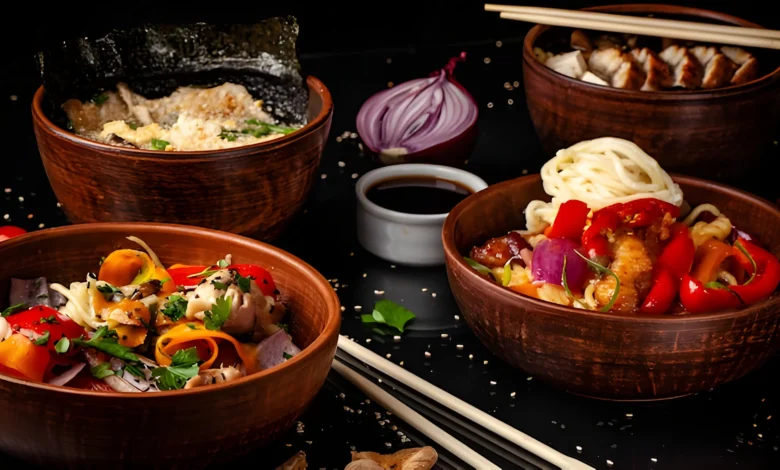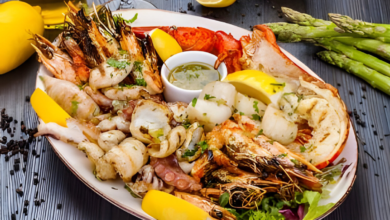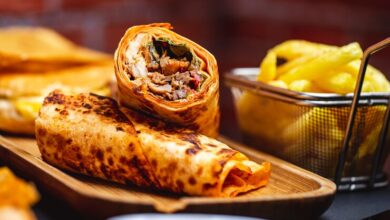Lunch Special: Chinese Food Near Me: Discover Culinary Delights

Introduction to Chinese Cuisine and Lunch Specials
Chinese Food Near Me Lunch Special has a rich culinary tradition that spans centuries. With its diverse flavors and regional variations, Chinese food has captured the taste buds of people around the world. In this blog post, we will explore the wonders of Chinese cuisine, with a special focus on lunch specials. From learning about the origins and influences of Chinese cuisine to uncovering the best lunch specials near you, get ready to embark on a flavorful journey.
A. Chinese Cuisine: A Rich Culinary Tradition
Chinese cuisine is renowned for its complex flavors, vibrant colors, and careful attention to detail. The origins of Chinese cuisine can be traced back thousands of years, with influences from various regions and dynasties shaping its diverse nature.
1. Origins and Influence
Chinese cuisine has been heavily influenced by the geography, climate, and cultures of different regions in China. The northern part of China, for example, developed a preference for wheat-based dishes like noodles and dumplings due to the availability of wheat crops. Meanwhile, the coastal regions embraced seafood and a wider range of vegetables in their cooking.
2. Key Ingredients and Flavors
The foundation of Chinese cuisine lies in its key ingredients, such as soy sauce, rice vinegar, ginger, garlic, and five-spice powder. These ingredients contribute to the distinct umami flavor that is characteristic of Chinese dishes. Furthermore, the balance of sweet, sour, salty, and spicy flavors is integral to Chinese cooking, creating a harmonious and satisfying culinary experience.
3. Regional Variations
China is a vast country with diverse landscapes and climates, resulting in distinct regional variations in its cuisine. From the fiery Szechuan cuisine to the delicate flavors of Cantonese cuisine, each region offers its own unique culinary delights. Exploring these regional variations allows you to uncover the rich tapestry of Chinese cuisine.
B. The Popularity of Lunch Specials
Lunch specials have gained immense popularity in Chinese restaurants. Offering affordable and convenient options, these specials allow patrons to experience the essence of Chinese cuisine in a convenient and budget-friendly manner.
1. Affordable and Convenient Options
Chinese lunch specials are priced competitively to attract customers during the lunchtime rush. They usually include a main dish, rice or noodles, and a side dish, providing a satisfying and complete meal. The affordability and variety of options make lunch specials a go-to choice for office workers and students alike.
2. Taste the Essence of Chinese Cuisine
Lunch specials give you the opportunity to taste a variety of Chinese dishes all in one meal. From classic favorites to lesser-known delicacies, these specials showcase the breadth and depth of Chinese cuisine. By indulging in lunch specials, you can experience the authentic flavors of China without breaking the bank.
3. Exploring New Dishes
Chinese lunch specials often feature rotating menus, allowing you to discover new dishes and expand your culinary horizons. This is an excellent way to step outside of your comfort zone and try something different. Who knows? You might just stumble upon your new favorite Chinese dish!
C. The Importance of Seeking Authenticity
When it comes to Chinese cuisine, seeking authenticity is key to truly savoring the delights it has to offer. By identifying authentic Chinese restaurants and understanding the menu and etiquette, you can ensure an authentic and enjoyable dining experience.
1. Identifying authentic Chinese restaurants
To find authentic Chinese cuisine, look for restaurants that have a predominantly Chinese clientele or are owned and operated by Chinese immigrants. These establishments often take pride in preserving traditional cooking techniques and flavors.
2. Types of Restaurants Offering Lunch Specials
Lunch specials are commonly found in casual Chinese restaurants, where you can enjoy a relaxed dining experience. Dim sum restaurants, noodle houses, and family-owned eateries often feature lunch specials on their menus.
3. Understanding the Menu and Etiquette
When visiting a Chinese restaurant, take the time to understand the menu and its offerings. Don’t hesitate to ask the staff for recommendations or clarification on any unfamiliar dishes. Additionally, familiarize yourself with basic Chinese dining etiquette, such as using chopsticks and proper table manners, to fully immerse yourself in the dining experience.
II. Unveiling the Best Lunch Specials Near You
Now that you understand the basics of Chinese cuisine and the allure of lunch specials, it’s time to uncover the best lunch specials near you. By navigating local Chinese restaurants, mastering the art of ordering from lunch special menus, and catering to specific dietary preferences, you can ensure a satisfying dining experience.
A. Navigating Local Chinese Restaurants
1. Researching Nearby Chinese Eateries
To find the best lunch specials near you, start by researching nearby Chinese restaurants. Use online platforms and apps that provide restaurant listings, menus, and customer reviews. This will help you narrow down your options and find the right restaurant for your lunchtime escapade.
2. Evaluating Ratings and Reviews
Once you have a list of potential restaurants, evaluate their ratings and reviews. Pay attention to comments about the quality of the food, portion sizes, and value for money. This will give you a better idea of what to expect and which restaurants are worth trying.
3. Asking for recommendations
Don’t underestimate the power of personal recommendations. Ask friends, colleagues, or even your server at a Chinese restaurant for their favorite lunch specials. This insider knowledge can lead you to hidden gems and ensure a memorable dining experience.
B. The Art of Ordering from Lunch Special Menus
Ordering from a lunch special menu requires a bit of finesse and consideration. By exploring variety and portions, identifying popular lunch specials, and balancing taste and nutritional value, you can make the most of your lunchtime feast.
1. Exploring Variety and Portions
One of the advantages of lunch specials is the opportunity to sample a variety of dishes. Look for lunch specials that offer a combination of proteins, vegetables, and carbohydrates. This ensures a well-rounded and satisfying meal. Furthermore, pay attention to portion sizes to avoid overordering or leaving the table still hungry.
2. Identifying popular lunch specials
Popular lunch specials are often a crowd favorite for a reason. They give you a taste of the restaurant’s specialty dishes and showcase their culinary expertise. Keep an eye out for dishes that are frequently recommended or highly rated by other diners.
3. Balancing Taste and Nutritional Value
While indulging in the flavors of Chinese cuisine is a delight, it’s important to maintain a balanced diet. Look for lunch specials that incorporate a variety of vegetables and lean proteins. Opt for steamed or stir-fried dishes instead of deep-fried options. This way, you can savor the taste while also nourishing your body.
C. Embracing Dietary Preferences and Needs
Chinese cuisine caters to a wide range of dietary preferences and needs. Whether you’re a vegetarian, following a gluten-free diet, or managing allergies, there are options available to suit your requirements.
1. Options for Vegetarians and Vegans
Vegetarian and vegan options are abundant in Chinese cuisine. From vegetable stir-fries to tofu-based dishes, there are plenty of flavorful and satisfying choices. Don’t hesitate to inform your server about your dietary preferences, as they can guide you towards the best options.
2. Catering to Gluten-Free Diets
Chinese cuisine offers various gluten-free options. Rice-based dishes, such as fried rice or rice noodle stir-fries, are naturally gluten-free. Additionally, dishes made with cornstarch instead of wheat-based sauces are a safe choice. However, it’s essential to communicate your dietary needs to ensure a gluten-free meal.
3. Managing allergies and food restrictions
If you have food allergies or restrictions, it is crucial to inform the restaurant staff. Chinese cuisine often contains ingredients like peanuts, shellfish, and soy, which can be allergens for some individuals. By communicating your allergies and restrictions, the restaurant can accommodate your needs and provide you with a safe and enjoyable dining experience.
III. Savoring the Delights of Chinese Lunch Specials
Now that you’ve discovered the best lunch specials near you and understand how to tailor your experience to your dietary preferences, it’s time to savor the delights of Chinese lunch specials. From signature dishes and must-try flavors to regional Chinese delicacies and unique lunch specials, prepare your taste buds for a remarkable culinary journey.
A. Signature Dishes and Must-Try Flavors
Chinese cuisine is known for its signature dishes and distinctive flavors. When exploring lunch specials, keep an eye out for these must-try flavors:
1. Popular Protein Choices
Protein is a vital component of Chinese cuisine, and lunch specials often feature a variety of protein options. From succulent orange chicken to savory kung pao shrimp, each dish offers its own unique blend of flavors.
2. Noodle and Rice Specialties
Noodles and rice are staples in Chinese cuisine and are often the star of lunch specials. From classic fried rice to aromatic lo mein, these dishes provide a comforting and satisfying base for other flavors to shine.
3. Iconic Sauces and Seasonings
Chinese cuisine is renowned for its flavorful sauces and seasonings. From the rich hoisin sauce to the spicy and tangy Szechuan sauce, these condiments add depth and complexity to any dish.
B. Exploring Regional Chinese Delicacies
China boasts a diverse culinary landscape, with each region offering its own unique delicacies. When diving into lunch specials, be sure to explore these regional favorites:
1. Cantonese Cuisine: Dim Sum and Beyond
Cantonese cuisine is known for its delicate flavors and dim sum, a style of small plates traditionally enjoyed during brunch. Try lunch specials that feature dim sum classics like har gow (shrimp dumplings) or siu mai (pork dumplings) for a taste of Cantonese authenticity.
2. Szechuan Cuisine: Fiery and Flavorful
Szechuan cuisine is famous for its bold and fiery flavors. Look for lunch specials that feature dishes like mapo tofu (spicy tofu) or kung pao chicken to experience the tongue-numbing spice and explosion of flavors that Szechuan cuisine is known for.
3. Shanghai Cuisine: Steamed Dumplings and More
Shanghai cuisine focuses on preserving the natural flavors of ingredients. Indulge in lunch specials that highlight steamed dumplings, such as xiaolongbao (soup dumplings), or classic dishes like sweet and sour pork to capture the essence of Shanghai cuisine.
C. Uncovering Unique Lunch Specials
To make your lunch special experience even more exciting, keep an eye out for these unique offerings that push the boundaries of traditional Chinese cuisine:
1. Chef’s Specials and Daily Rotations
Some Chinese restaurants offer chef’s specials or daily rotations as part of their lunch specials. These dishes are often experimental and showcase the creativity of the chef. Embrace the element of surprise and be the first to taste innovative flavor combinations.
2. Seasonal Ingredients and Limited-Time Offers
Another way to uncover unique lunch specials is by exploring menus that incorporate seasonal ingredients or limited-time offers. This allows you to savor dishes that are only available during specific times of the year or for a limited duration. Step out of your culinary comfort zone and try something new and exciting.
3. Fusion Creations and Innovation
Chinese cuisine has evolved over the years, giving rise to fusion creations. Some restaurants blend Chinese flavors with other culinary traditions, creating unique and unexpected dishes. Explore lunch specials that incorporate elements of other cuisines for an innovative and adventurous dining experience.
IV. Tips for Enhancing Your Lunch Special Experience
To elevate your lunch special experience and fully immerse yourself in the world of Chinese cuisine, consider these tips:
A. Chinese Tea: Elevating the Meal
Chinese tea is an integral part of the dining experience, complementing the flavors of Chinese cuisine. Familiarize yourself with the art of tea and explore different types of tea to find the perfect accompaniment to your lunch special.
1. Understanding the Art of Tea
Chinese tea has a long history and is cherished for its refreshing and calming properties. Learn about the different tea varieties, such as green tea, oolong tea, and jasmine tea, to appreciate the nuances of Chinese tea culture.
2. Pairing Tea with Your Lunch Special
When selecting a tea to pair with your lunch special, consider the flavors of the dish. For example, jasmine tea complements delicate seafood flavors, while pu-erh tea enhances the robustness of meat dishes. Experiment with different tea and food pairings to find your personal preference.
3. Benefits of Chinese Tea
Chinese tea offers a range of health benefits, such as aiding digestion, boosting metabolism, and providing antioxidants. By incorporating tea into your lunch special experience, you not only enhance the flavors but also reap the health benefits it has to offer.
B. Etiquette and Customs to Embrace
Chinese dining etiquette and customs play an important role in the overall dining experience. Familiarize yourself with these customs to fully immerse yourself in the culture and show respect for Chinese culinary traditions.
1. Proper Use of Chopsticks
Using chopsticks correctly is essential in Chinese dining. Practice proper chopstick etiquette, such as not sticking them vertically into your food or crossing them on the table. This shows respect for the culture and enhances the overall dining experience.
2. Dining Etiquette and Table Manners
Chinese dining etiquette emphasizes communal dining and sharing. Be mindful of others at the table, and wait for the host or oldest person to start eating before you dig in. Additionally, avoid wasting food, as it is considered disrespectful. Take only what you can eat and savor each bite.
3. Traditions to Be Aware of
China has a rich cultural heritage, and understanding certain traditions can enhance your special lunch experience. For example, during the Chinese New Year, certain dishes symbolize prosperity and good luck. Partaking in cultural celebrations and experiencing traditional Chinese customs adds an extra layer of depth to your dining experience.
C. Expanding Your Chinese Culinary Horizons
If you’re truly captivated by the wonders of Chinese cuisine, why not take it a step further? Expand your Chinese culinary horizons by trying new flavors and dishes, learning to cook Chinese cuisine, and participating in cultural celebrations.
1. Trying New Flavors and Dishes
Venture beyond your usual choices and explore new flavors and dishes in Chinese cuisine. Challenge yourself to try something you’ve never had before, whether it’s a unique ingredient or an unconventional flavor combination. You might discover a new favorite dish that you never knew existed.
2. Learning to cook Chinese cuisine
For those with a passion for cooking, learning to prepare Chinese cuisine can be a rewarding experience. Experiment with different recipes, techniques, and ingredients to recreate the flavors of your favorite Chinese dishes at home. This allows you to immerse yourself in the culture and share the joys of Chinese cuisine with family and friends.
3. Participating in Cultural Celebrations
Chinese cuisine is not just about the food; it’s a whole experience. If you’re looking to dive into the flavors and traditions of Chinese culture, participating in cultural celebrations is a fantastic way to do so.
Chinese festivals, such as Chinese New Year, Mid-Autumn Festival, and Dragon Boat Festival, are filled with vibrant colors, exhilarating performances, and, of course, mouth-watering food. These celebrations offer a unique opportunity to immerse yourself in the rich heritage and discover culinary delights. Let’s take a deeper look at this exciting aspect of Chinese food culture.
Summary and FAQs
Summary of Chinese Cuisine and Lunch Specials
Chinese cuisine is diverse, with regional variations that offer a wide array of flavors and textures. From the fiery spices of Sichuan cuisine to the delicate balance of flavors in Cantonese dishes, Chinese food is a feast for the senses. While Chinese food is renowned for its dinner options, lunch specials also hold a special place in the hearts and stomachs of food enthusiasts.
Chinese lunch specials are often an affordable and convenient way to enjoy a delicious midday meal. Many Chinese restaurants offer lunch menus with a selection of traditional dishes at discounted prices. These specials not only introduce you to the unique flavors of Chinese cuisine but also give you a chance to try a variety of dishes without breaking the bank.
Frequently Asked Questions
1. What is a common Chinese lunch?
A common Chinese lunch typically consists of a few different dishes that are meant to be shared. One popular option is the “Lunch Special Combo,” which usually includes a main dish, such as Kung Pao Chicken or Sweet and Sour Pork, along with a side dish like fried rice or lo mein. For those looking for a lighter option, a bowl of hot and sour soup or a plate of steamed dumplings can make a satisfying meal.
2. What is the most popular Chinese meal?
One of the most popular Chinese meals is peking duck. This iconic dish originated in Beijing and features succulent roasted duck served with thin pancakes, scallions, and hoisin sauce. The crispy skin, tender meat, and flavorful condiments create a delectable combination that has won the hearts of food lovers around the world.
3. What is the most popular day for Chinese food?
Friday is often considered the most popular day to indulge in Chinese food. Many people look forward to ending their week with a tasty Chinese meal as a way to relax and treat themselves before the weekend. Whether it’s takeout or dining in at a Chinese restaurant, Friday nights are often filled with the tempting aromas and delightful flavors of Chinese cuisine.
4. What are Chinese special dishes?
Chinese cuisine offers a wide range of special dishes that showcase the depth and variety of Chinese culinary traditions. Some notable Chinese specialties include:
- Mapo Tofu: A spicy and flavorful dish made with soft tofu, minced pork, and a fiery chili bean paste. This Sichuan staple packs a punch of flavor and is loved for its satisfying texture.
- Xiaolongbao: These steamed soup dumplings are a true delicacy. Filled with a savory broth and meaty filling, each bite bursts with flavor. Eating Xiaolongbao requires careful technique to avoid any spills or drips.
- Kung Pao Chicken: This classic dish is a stir-fry delight with chunks of tender chicken, peanuts, and a medley of vegetables. The combination of sweet, tangy, and spicy flavors makes it a favorite among many.
Now that we’ve explored the cultural celebrations that surround Chinese cuisine and answered some common questions, it’s time for you to embark on your culinary adventure. Head out and explore the Chinese restaurants near you, join in on the festivities, and let your taste buds savor the wonders of Chinese food.
Remember, food is not just sustenance; it’s a gateway to understanding different cultures and appreciating their traditions. So go ahead, try the lunch specials, discover new flavors, and embrace the culinary heritage of China.
“Food is the ingredient that binds us together, transcending language and cultural barriers.” – Unknown




